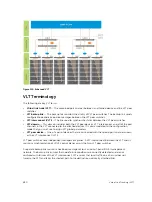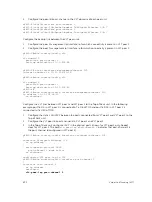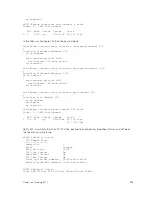
• You can only use one spanned VLAN from a PIM-enabled VLT node to an external neighboring PIM
router.
• If you connect multiple spanned VLANs to a PIM neighbor, or if both spanned and non-spanned
VLANs can access the PIM neighbor, ECMP can cause the PIM protocol running on each VLT peer
node to choose a different VLAN or IP route to reach the PIM neighbor. This can result in issues with
multicast route syncing between peers.
• Both VLT peers require symmetric Layer 2 and Layer 3 configurations on both VLT peers for any
spanned VLAN.
• For optimal performance, configure the VLT VLAN routing metrics to prefer VLT VLAN interfaces over
non-VLT VLAN interfaces.
• When using factory default settings on a new switch deployed as a VLT node, packet loss may occur
due to the requirement that all ports must be open.
• ECMP is not compatible on VLT nodes using VLT multicast. You must use a single VLAN.
Configuring VLT Multicast
To enable and configure VLT multicast, follow these steps.
1.
Enable VLT on a switch, then configure a VLT domain and enter VLT-domain configuration mode.
CONFIGURATION mode
vlt domain
domain-id
2.
Enable peer-routing.
VLT DOMAIN mode
peer-routing
3.
Configure the multicast peer-routing timeout.
VLT DOMAIN mode
multicast peer-routing—timeout
value
value
: Specify a value (in seconds) from 1 to 1200.
4.
Configure a PIM-SM compatible VLT node as a designated router (DR). For more information, refer to
Configuring a Designated Router
.
5.
Configure a PIM-enabled external neighboring router as a rendezvous point (RP). For more
Configuring a Static Rendezvous Point
.
6.
Configure the VLT VLAN routing metrics to prefer VLT VLAN interfaces over non-VLT VLAN
interfaces. For more information, refer to
7.
Configure symmetrical Layer 2 and Layer 3 configurations on both VLT peers for any spanned VLAN.
Non-VLT ARP Sync
ARP entries (including ND entries) learned on other ports are synced with the VLT peer to support station
move scenarios.
NOTE: ARP entries learned on non-VLT, non-spanned VLANs are not synced with VLT peers.
RSTP Configuration
RSTP is supported in a VLT domain.
Before you configure VLT on peer switches, configure RSTP in the network. RSTP is required for initial
loop prevention during the VLT startup phase. You may also use RSTP for loop prevention in the network
Virtual Link Trunking (VLT)
861
Содержание Z9000
Страница 1: ...Dell Configuration Guide for the Z9000 System 9 7 0 0 ...
Страница 80: ...grub reboot 80 Management ...
Страница 128: ... 0 Te 1 1 Te 1 2 rx Flow N A N A 128 Access Control Lists ACLs ...
Страница 436: ...Figure 50 Inspecting Configuration of LAG 10 on ALPHA 436 Link Aggregation Control Protocol LACP ...
Страница 439: ...Figure 52 Inspecting a LAG Port on BRAVO Using the show interface Command Link Aggregation Control Protocol LACP 439 ...
Страница 440: ...Figure 53 Inspecting LAG 10 Using the show interfaces port channel Command 440 Link Aggregation Control Protocol LACP ...
Страница 491: ...Figure 70 Configuring OSPF and BGP for MSDP Multicast Source Discovery Protocol MSDP 491 ...
Страница 492: ...Figure 71 Configuring PIM in Multiple Routing Domains 492 Multicast Source Discovery Protocol MSDP ...
Страница 496: ...Figure 73 MSDP Default Peer Scenario 1 496 Multicast Source Discovery Protocol MSDP ...
Страница 497: ...Figure 74 MSDP Default Peer Scenario 2 Multicast Source Discovery Protocol MSDP 497 ...
Страница 498: ...Figure 75 MSDP Default Peer Scenario 3 498 Multicast Source Discovery Protocol MSDP ...
Страница 760: ...Figure 100 Single and Double Tag TPID Match 760 Service Provider Bridging ...
Страница 761: ...Figure 101 Single and Double Tag First byte TPID Match Service Provider Bridging 761 ...






























